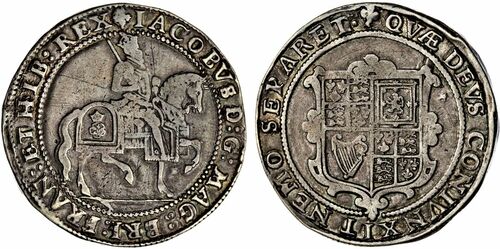
Auction: 23005 - The "Haddenham" Collection of English Coins
Lot: 539
The 'Haddenham' Collection of English Coins | James I (1603-1625), Third Coinage, Crown, 18 June 1624 - 7 July 1625, Tower, by Charles Anthony after Derick Anthony, (m.m.) IACOBVS D : G : MAG : BRIT : FRAN : ET HIB : REX, D over E (?), King on horseback trotting right, grassy ground line below, rev. (m.m.) QVÆ DEVS CONIVNXIT NEMO SEPARET •, no stops in legend except after SEPARET, square-topped and lightly garnished shield, 29.72g [458.8grns], 1h, m.m. trefoil over lys [both sides] (FRC X*/XVIII* [sale lot 35] = Tallent 40; Lingford 64 same dies; Lockett 3340 same dies; Slaney II, 326 same dies; North 2120; Spink 2664), hairline pin scratch behind King in obverse fields, softly struck to key devices and usual die clogging to peripheries, otherwise old cabinet tone, the centres close to fine, the rest good fine, the double over-mark scarce and seldom encountered in public commerce
Provenance
T Mathews, by private treaty, 1985 - £315
F R Cooper in his die study for the Jacobean Silver Crown coinage for the BNJ 1970, observed: "The silver crowns of James I, the design of which remained basically unchanged throughout the reign, must thus be attributed to the two artists, Charles Anthony and John Baptist van Landen. In the design of the equestrian portrait the former may well have been influenced by his father, Derick, who executed a somewhat similar portrait of Edward VI in 1551 shortly after his appointment to the post which passed direct to his son nearly fifty years later. Although the third coinage which dates from 1619 was considered by Morrieson to be of coarser workmanship, and hence the product of another engraver, no evidence has been traced to show it was the work of Holle. In the crown series there seems little inferiority, although on some third-coinage dies the lettering is very untidy. Possibly also due to wear of the main puncheon the equestrian portrait shows less detail; but third-coinage strikings are generally bolder and in higher relief than those of the first and second coinages. It will further be noted that with some
of the third-coinage reverses the placing and the proportion of the shield are not well thought out. Nevertheless it is difficult to make general comparisons when many die impressions are known only in a poor state of preservation."
Subject to 20% VAT on Buyer’s Premium. For more information please view Terms and Conditions for Buyers.
Sold for
£1,000
Starting price
£300




